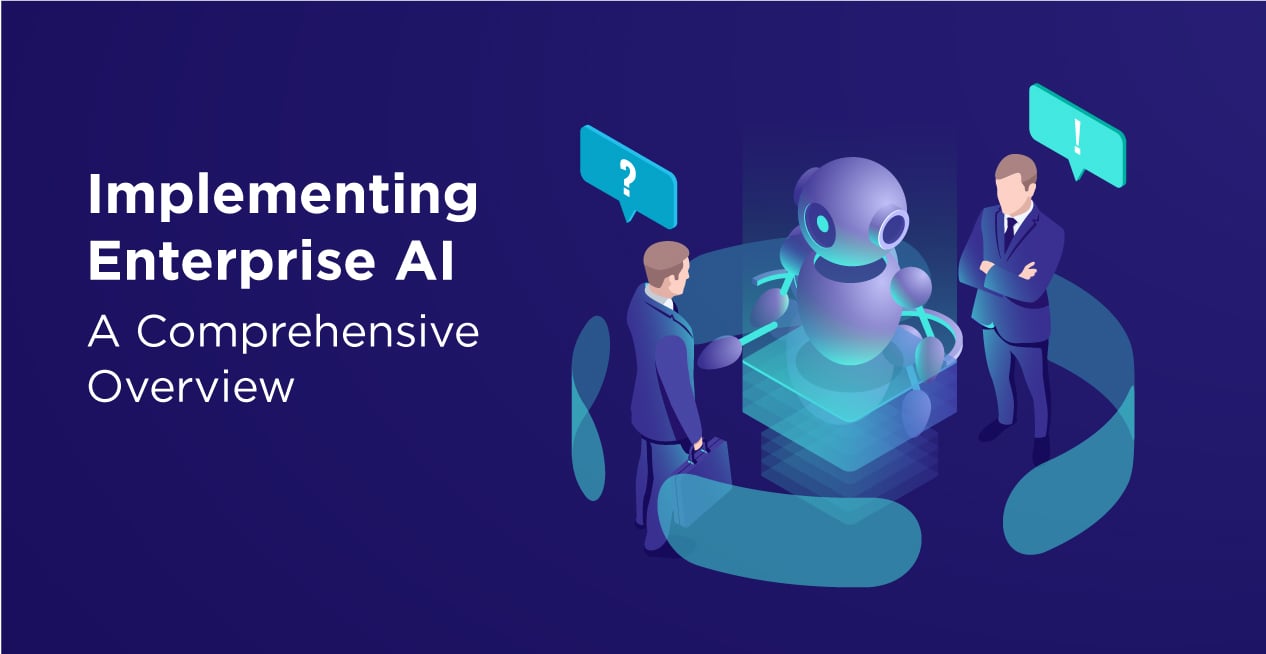Introduction
Enterprise applications are taking the world by storm. As a leading tool in digital transformation, enterprise applications are reforming the way enterprises function. Enterprise applications refer to computing systems that either automate or refine organizational workflows in a business. A few commonly used enterprise applications are- Enterprise Resource Planning (E.R.P.) Systems, Supply Chain Management (S.C.M.) Systems, Customer Relationship Management (C.R.M.) Systems and Knowledge Management Systems (K.M.S.) but more about them later. First let us have a look at why these systems are being incorporated by businesses at a lightning pace, especially in the last decade.
The latest trend in enterprise systems is the integration of AI in such systems which have only increased the efficiency and productivity of the organization as a whole. AI-led enterprise applications have also proven to have enhanced customer service, improved sales, secured and optimized supply chains, reimagine enterprise search services and helped develop improved and innovative products. Before we delve into the ways that AI is reinventing enterprises, let’s have a look into AI, its inception, and the way it works.
What is AI and how does it work?
Artificial Intelligence refers to imbibing computing systems with an ability to think like a human and make rational decisions similar to them. It does so by implementing technologies of Machine Learning, Natural Language Processing(NLPs), and more.
Computers integrated with AI at times are also known to act and think like humans. Generative AI tools and enterprise ai platforms like ChatGPT and Google’s Bard, self-driving cars, and automated intelligent chatbots are some fine examples of mainstream integration of artificial intelligence into our daily life. AI led enterprise applications are the future and are gaining popularity at an astonishing rate.
Challenges of AI integration in enterprise applications
Until very recently, AI for enterprise level sounded lucrative but had its own set of challenges. A few of the major challenges were:
- Artificial intelligence and its domain were undergoing rapid and instantaneous change and it was difficult for companies to keep up with technological requirements for the same.
- There was a marked shortage of IT professionals who were not equipped to run AI operations and projects. With new avenues opening up, this is changing as people are investing in uplifting their skill sets with AI.
- Enterprises were not actively employing AI in their applications as they did not understand the benefits or the process of the same. There was also a certain skepticism regarding automation with AI as it was an expensive affair for many.
Benefits of AI-led Enterprise Applications
For new-found businesses, AI-led applications are a boon. Here are some benefits that AI-led applications bring to the table.
Automation
One of the most often mentioned advantages of AI technology is automation, which has had a big influence on the consumer goods, transportation, communications, and service sectors. In these industries, automation not only boosts output and productivity but also makes better use of raw resources, produces goods with greater quality, cuts lead times, and improves safety. Additionally, automation can aid in resource liberation for use in other crucial endeavors.
Smart Decision Making
Smart decision-making is a given with enterprises equipped with AI. Artificial intelligence (AI) technology helps plan data supply, assess trends, create data consistency, offer predictions, and quantify uncertainties. It takes business decisions while staying impartial on the subject at hand. The decisions are directed to maximize efficiency and imitate humane decision-making ability.
Better customer service
AI-led enterprise applications reinvent client experience and client support. Personalized marketing, real-time insights, and Voice recognition systems further streamline customer service and cater to users individually.
Improved monitoring
AI instinctively can interpret data in real-time, and businesses can set up almost immediate monitoring. For instance, image recognition software and machine learning models are used in quality control procedures on factory floors to monitor production and identify issues.
Improved speed of business
Integrating AI in business workflows has also led to shorter business cycles all the while automating internal as well as user end. Reducing the time to move from one stage to the next, such as from designing a product to commercialization, results in a faster ROI.
Better quality
Automating business processes also results in a reduction of errors and increased adherence to compliance standards.
Types of Artificial Intelligence
AI is usually categorized into four types, two of which are yet to be achieved. Given below are the types of AI.
Reactive AI
One of the earliest types, Reactive AI, marked the initial idea of Artificial Intelligence. It relied on reactive, memoryless algorithms that always produced the same result given a given input. This kind of AI is useful for basic categorization and pattern recognition tasks in machine learning models. Even though they can process vast amounts of data, they are unable to analyze scenarios that include incomplete information or need knowledge of the past.
Limited memory machines
Limited memory machines use algorithms that mimic the connections between neurons in the human brain, drawing on our knowledge of this structure. In addition to handling difficult categorization problems and using historical data to create predictions, this kind of machine learning, or deep learning, can accomplish difficult tasks like autonomous driving.
Limited memory machines are categorized as having narrow intelligence since they fall short of humans in other areas even if they can accomplish tasks considerably better than the average person can.
Theory of mind
It is believed that this type of hypothetical AI that is now in existence can understand human thinking and goals, enabling it to give personalized results depending on each person’s desires and intentions. Another term for artificial general intelligence is the theory of mind. Artificial Intelligence can learn from fewer examples than machines but with limited memory. It may generalize, contextualize, and apply information to a variety of problems. The next big step in the evolution of AI, emotion AI—the ability to detect human emotions and experience empathy for others. This is still in its early phases of development, even though the systems under research do not exhibit a theory of mind and are far from self-awareness.
Self-aware AI
This kind of AI is conscious of both its mental state and the states of other entities. A computer with an intellect comparable to human general intelligence and the potential to significantly outperform human cognition. This can be achieved by producing ever more intelligent versions of itself is referred to as self-aware AI, also known as artificial superintelligence. But at this point, our understanding of the structure of the human brain is insufficient to create an artificial one that is at least as clever as the human brain.
Types of Enterprise AI
Though Self aware AI and Theory of mind are still in the development phase given the technological limitations of the current tech markets, there are few categories that enterprises are already integrating in their operational workflows.
Text AI
One of the most prevalent enterprise AI is Text AI. It entails using language and written information to teach and utilize artificial intelligence. Text AI covers a variety of functions such as speech recognition, audio transcription amongst others.
Analytical AI
Analytical Artificial Intelligence revolves around gathering information by analyzing copious amounts of data. Machines, when delegated with mapping out patterns and recognizing user behavior, produce much more accurately and precisely. This can be attributed to machine learning and deep neural networks which easily spot patterns and provide gainful insights.
Interactive AI
Interactive AI systems help improve and create more engaging experiences for consumers. Virtual assistants and other interactive AI systems reinvents consumer experience by tools such as Natural Language processing and conversational analytics.
For example, an artificial intelligence-enabled IVR system may let a consumer phone a contact center to finish a transaction, seek access to a particular employee, or make account changes.
Visual AI
Visual AI aka Computer vision is yet another excellent example of enterprise AI. It helps analyze and fundamentally ‘read’, ‘scan’ and ‘identify’ an image or a visual object.
Functional AI
Functional AI refers to intelligent automation of workflows in daily operations. Examples of Functional AI are: Manufacturing robots, self-driving cars, smart assistants, Healthcare management, automated financial investing, virtual travel booking agent, social media monitoring, marketing chatbots.
Ways Businesses can implement AI
There are many ways businesses can implement AI and are already doing so. Common use cases of AI-integrated enterprise applications are great examples of understanding their implementation and the benefits it brings to the table..
Security
Machine Learning has elevated and eased the analysis of humongous amounts of data safely and securely. Artificial intelligence further adds to the security of operational workflows and encourages transparency. Companies can enhance the security of their operations by integrating ML techniques into their enterprise applications.
Automated Risk Assessment
AI-driven fintech businesses are doing exceedingly well by automating risk assessments of their projects and transactions. This not only guarantees compliance to regulations but also provides financial resilience, and reduces losses while facilitating credit scoring.
Algorithmic Trading
Fintech companies are actively leveraging AI to deploy tailored trading strategies for retail traders, enhance their trading operations, and provide robust fraud detection solutions.
Targeted Marketing
With the use of artificial intelligence, marketers can now evaluate enormous volumes of data in real time and forecast outcomes, increasing precision. This further gives consumers more customized and targeted ad experiences. Advertising platforms driven by AI may also automate ad space bidding tactics, ensuring that advertisers receive the best possible price for their advertisements.
These are, but a few, examples of the way AI is reinventing the digital space. Health companies, fintech companies, and many other industries are actively employing AI and reaping its benefits as we speak.
Conclusion
Enterprise Application Development coupled with AI is the latest trend moving the markets. The extent to which is evident by the exponential increase in demand for a reliable enterprise software development company. OpenXcell is one such software development company well equipped with the expertise to develop AI-integrated enterprise applications. The company boasts of a rich portfolio of successful projects and a huge roster of happy clients.









